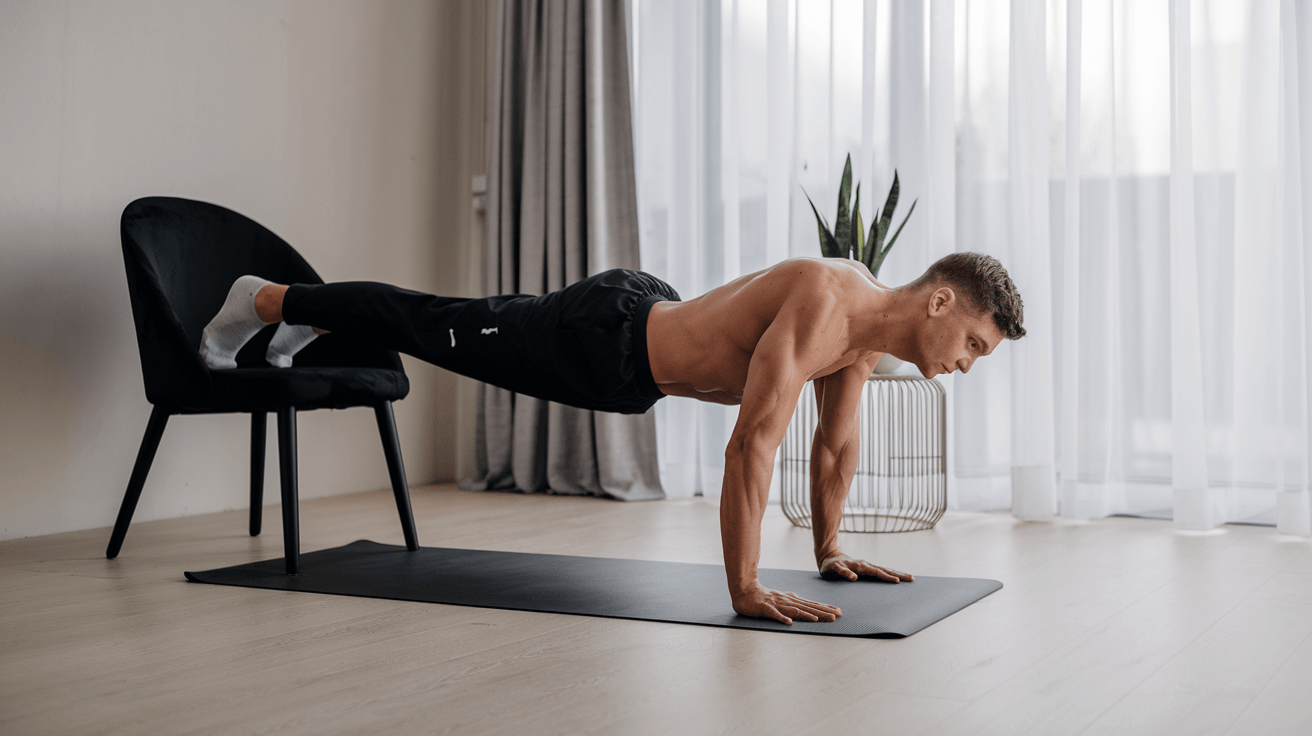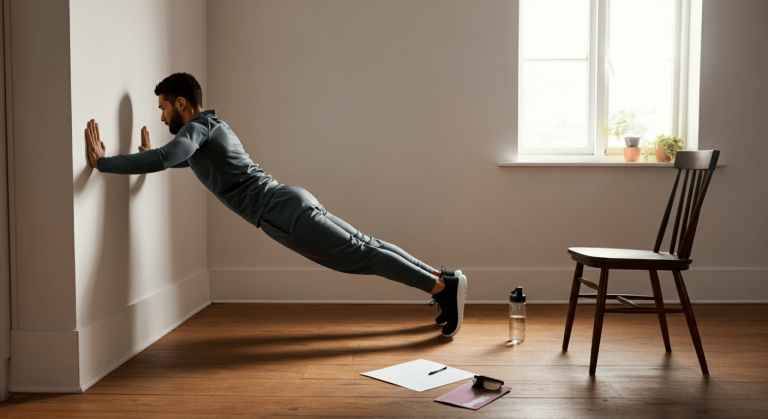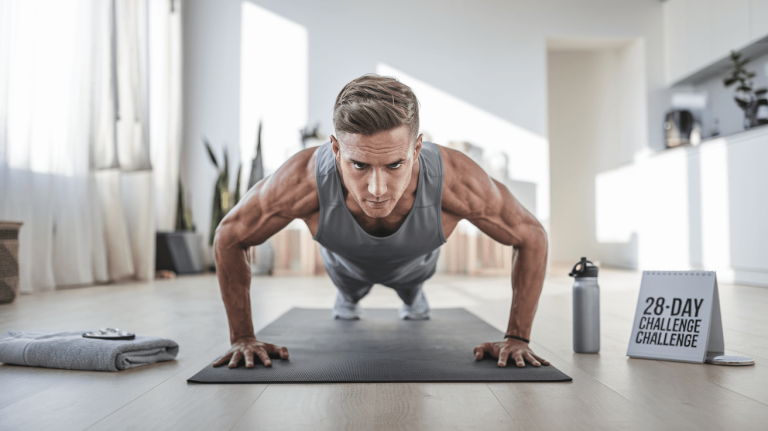Calisthenics for Beginners: The Fail-Proof Progression Plan to Build Real Strength at Home
Are you tired of feeling like you need a complex, expensive gym membership to get strong? Do you want to build a powerful physique but feel intimidated by heavy weights and worried about getting injured starting out? Many people begin a fitness journey with great enthusiasm, only to hit a wall. They lack a clear progression plan, get frustrated by a lack of results, or fear they are performing exercises incorrectly. This guide is different.
This is not just another list of exercises. This is a complete blueprint designed to teach you how to start calisthenics with no experience and build real, functional strength. We will provide you with a day-by-day, four-week at home calisthenics workout for beginners. More importantly, we will teach you the principles of progression—the fail-proof system that ensures you can continue getting stronger long after these initial four weeks are over. You will learn how to listen to your body, master perfect form, and build a foundation of strength that will serve you for a lifetime, all from the comfort of your own home.
Table of Contents
- The Foundations: Why Calisthenics is the Ultimate At-Home Workout
- The 4-Week Calisthenics Workout Plan for Beginners (No Equipment Needed)
- The Principle of Progression: Your System for Long-Term Strength
- Safety, Form, and Overcoming Common Hurdles
- Conclusion
- FAQ: Calisthenics for Beginners
The Foundations: Why Calisthenics is the Ultimate At-Home Workout
Before diving into the “how,” it’s crucial to understand the “why.” Establishing the core principles and benefits of calisthenics will build a strong foundation for your fitness journey, proving why it’s the most accessible and effective solution for building strength at home.
What is Calisthenics? More Than Just Bodyweight Exercises
At its core, calisthenics is the art and science of using your own bodyweight as resistance to build strength, improve coordination, and achieve a high level of physical mastery. While it includes many bodyweight exercises for beginners, it is much more than randomly performing push-ups and squats. Calisthenics is a discipline focused on methodical skill progression. Instead of adding more weight to a barbell, you advance by mastering more challenging variations of an exercise. This systematic approach is how to start calisthenics with no experience and build a truly powerful and capable body.
The Top 5 Benefits of Bodyweight Training for Beginners
For beginners, the advantages of choosing calisthenics are immense. It removes nearly every barrier to entry that new fitness enthusiasts face.
- Extremely Low Cost: Your body is the only equipment you need. This eliminates the significant expense of gym memberships and bulky home equipment.
- Low Impact on Joints: When performed with proper form, calisthenics exercises are gentle on your joints, reducing the risk of injury that can come with heavy weightlifting.
- Builds Functional Strength: The strength you build with calisthenics translates directly to real-world activities, improving your ability to push, pull, and move gracefully and powerfully through daily life.
- Workout Anywhere, Anytime: Your gym is wherever you are. This flexibility makes it far easier to stay consistent with your training, a key factor for long-term success. As the Military Health System notes, the accessibility of bodyweight training is one of its greatest assets.
- Improves Mind-Muscle Connection: Calisthenics requires you to focus intently on which muscles you’re using, enhancing the neural connection between your brain and your body. The American Council on Exercise (ACE) highlights this as a key benefit for improving movement quality and overall physical awareness.
This combination of accessibility and effectiveness makes an at home calisthenics workout for beginners the perfect starting point.
The 4-Week Calisthenics Workout Plan for Beginners (No Equipment Needed)
This is your actionable, day-by-day plan. The focus is on mastering form and building a consistent routine. For a convenient, printable version of this entire plan, download your free 4-Week Calisthenics for Beginners PDF. This structured approach is similar to a 30 day calisthenics challenge for beginners, designed to build momentum and deliver visible results with no equipment.
Your Weekly Schedule:
- Day 1: Upper Body & Core
- Day 2: Lower Body & Core
- Day 3: Rest or Active Recovery (e.g., light walk, stretching)
- Day 4: Upper Body & Core
- Day 5: Lower Body & Core
- Day 6 & 7: Rest
Week 1: Building the Foundation
Goal: Master the form of each exercise. Move slowly and deliberately. Quality over quantity is key.
| Exercise | Sets | Reps | Rest |
|---|---|---|---|
| Upper & Core | |||
| Incline Push-ups | 3 | 5-8 | 60-90 sec |
| Plank | 3 | 20-30s | 60 sec |
| Bodyweight Rows | 3 | 5-8 | 60-90 sec |
| Lower & Core | |||
| Bodyweight Squats | 3 | 8-12 | 60-90 sec |
| Glute Bridges | 3 | 10-15 | 60 sec |
| Leg Raises | 3 | 8-10 | 60 sec |
Week 2: Increasing Volume & Consistency
Goal: Increase the number of repetitions while maintaining perfect form. Your body is adapting, so it’s time to add a little more challenge.
| Exercise | Sets | Reps | Rest |
|---|---|---|---|
| Upper & Core | |||
| Incline Push-ups | 3 | 8-12 | 60-90 sec |
| Plank | 3 | 30-45s | 60 sec |
| Bodyweight Rows | 3 | 8-12 | 60-90 sec |
| Lower & Core | |||
| Bodyweight Squats | 3 | 12-15 | 60-90 sec |
| Lunges (per leg) | 3 | 8-10 | 60 sec |
| Glute Bridges | 3 | 15-20 | 60 sec |
Week 3: Introducing Intensity
Goal: Introduce slightly harder exercise variations. If Incline Push-ups feel manageable, try moving to Knee Push-ups.
| Exercise | Sets | Reps | Rest |
|---|---|---|---|
| Upper & Core | |||
| Knee Push-ups | 3 | 5-8 | 60-90 sec |
| Leg-Lift Plank | 3 | 30s hold | 60 sec |
| Bodyweight Rows | 3 | 12-15 | 60-90 sec |
| Lower & Core | |||
| Paused Squats | 3 | 8-10 | 60-90 sec |
| Lunges (per leg) | 3 | 10-12 | 60 sec |
| Single-Leg Glute | 3 | 8-10 | 60 sec |
Week 4: Pushing Your Limits
Goal: Consolidate your strength. Push to the higher end of the repetition ranges for each exercise, preparing you to graduate from this plan.
| Exercise | Sets | Reps | Rest |
|---|---|---|---|
| Upper & Core | |||
| Knee Push-ups | 3 | 8-12 | 60-90 sec |
| Plank | 3 | 60s hold | 60 sec |
| Bodyweight Rows | 3 | 15+ | 60-90 sec |
| Lower & Core | |||
| Paused Squats | 3 | 10-15 | 60-90 sec |
| Lunges (per leg) | 3 | 12-15 | 60 sec |
| Single-Leg Glute | 3 | 10-15 | 60 sec |
The Principle of Progression: Your System for Long-Term Strength
The 4-week plan above is just the beginning. The real secret to long-term success in calisthenics is understanding the principle of progressive overload. Instead of adding plates to a bar, you make the exercise itself more challenging. This is the calisthenics progression plan for beginners that ensures you never plateau. A well-structured plan, like the famous beginner bodyweight workout from Nerd Fitness, is built on this very principle. Below is your guide on how to start calisthenics with no experience and continue progressing for months.
Progression for Push-Ups: From the Wall to the Floor
The push-up is a fundamental upper-body strength builder. The key is to reduce the amount of your bodyweight you are lifting at the start.
- Wall Push-ups: Stand facing a wall. Place your hands on the wall and perform a push-up. This is the easiest variation.
- Incline Push-ups: Place your hands on an elevated surface like a sturdy table or bench. The higher the surface, the easier the exercise. As you get stronger, use lower surfaces.
- Knee Push-ups: Perform a push-up from your knees. This is the final step before a full push-up.
- Full Push-ups: The classic push-up from your toes with a straight body line.
Progression for Squats: Building Leg Strength
The bodyweight squat is the king of lower-body exercises. Master the basic form before adding intensity.
- Bodyweight Squats: Focus on perfect form: chest up, back straight, and hips dropping below the knees.
- Paused Squats: Hold the bottom position of the squat for 2-3 seconds before pushing back up. This removes momentum and builds strength in the hardest part of the lift.
- Close-Stance Squats: Bring your feet closer together. This variation places more emphasis on the quadriceps and requires greater stability.
Progression for Core: Beyond the Basic Plank
A strong core is the foundation of all movement. The plank is your starting point for building incredible stability.
- Knee Plank: The starting point. Hold a plank position resting on your forearms and knees instead of your toes.
- Full Plank: The standard plank, holding a perfectly straight line from your head to your heels, supported on your forearms and toes.
- Leg-Lift Planks: From a full plank position, slowly lift one leg off the ground for a few seconds without letting your hips sag. Alternate legs.
Safety, Form, and Overcoming Common Hurdles
Building true strength requires a smart approach. Focusing on safety, proper form, and proactively addressing common challenges will prevent injury and keep you motivated. This is especially important for calisthenics for overweight beginners and calisthenics for women beginners, where specific modifications can make all the difference.
The Perfect Calisthenics Warm-Up and Cool-Down
Never skip your warm-up. A proper warm-up increases blood flow to your muscles and prepares your joints for movement, drastically reducing the risk of injury. A good calisthenics warm up for beginners only takes five minutes.
5-Minute Warm-Up:
- Jumping Jacks (60 seconds)
- Arm Circles (30 seconds forward, 30 seconds backward)
- Torso Twists (60 seconds)
- Leg Swings (30 seconds per leg, forward/backward and side-to-side)
- High Knees (60 seconds)
After your workout, a cool-down helps your body begin the recovery process.
5-Minute Cool-Down:
- Quad Stretch (30 seconds per leg)
- Hamstring Stretch (30 seconds per leg)
- Chest Stretch in a doorway (30 seconds)
- Child’s Pose (60 seconds)
How to Go From 0 to 1 Pull-Up (A Special Focus)
The pull-up is a milestone for many. If you can’t do one yet, don’t worry. Follow this micro-progression:
- Dead Hangs: Simply hang from a pull-up bar for as long as you can. This builds foundational grip strength. Aim for 3 sets of 30-second holds.
- Scapular Pulls: While hanging from the bar, pull your shoulder blades down and back, lifting your body slightly without bending your arms. This isolates and strengthens the key muscles for initiating a pull-up.
- Negative Pull-ups: Use a chair to get your chin over the bar. Then, as slowly as you possibly can, lower yourself down until your arms are straight. This builds the eccentric strength needed for the full movement.
Modifications for Overweight Beginners and Common Injuries
Calisthenics is for every body type. For calisthenics for overweight beginners, the key is to modify exercises to reduce the load. Using incline variations for exercises like push-ups is the single most effective strategy. By placing your hands on a wall or a high countertop, you decrease the percentage of your bodyweight you have to lift, making the exercise manageable and safe for your joints. Focus on exercises with less impact, like glute bridges and bodyweight rows, to build a strong base before attempting higher-impact movements.
Conclusion
You now have a complete system to build real, functional strength at home. Calisthenics is the most accessible and effective method for any beginner to transform their physique and fitness. Remember, the key to success isn’t just following a workout plan—it’s understanding the principle of progression. You’ve been given a 4-week roadmap and, more importantly, the knowledge to navigate your own fitness journey for months and years to come. You have the tools to overcome plateaus, stay safe, and build a body you can be proud of.
Ready to start your journey? Download your free 4-Week Calisthenics for Beginners PDF and take the first step toward a stronger, healthier you.
FAQ: Calisthenics for Beginners
How quickly will I see results from calisthenics?
With consistent training (3-4 times per week) and good nutrition, you can expect to feel stronger and notice improvements in muscle definition within 4 to 8 weeks. Initial gains are often rapid as your nervous system becomes more efficient at recruiting muscles.
Is calisthenics good for weight loss, especially for overweight beginners?
Yes, absolutely. Calisthenics builds muscle, and muscle tissue burns more calories at rest than fat tissue, boosting your metabolism. When combined with a sensible diet, a consistent calisthenics routine is an excellent tool for weight loss. For overweight beginners, starting with low-impact modifications is key to burning calories safely.
Can women build muscle with calisthenics?
Definitely. Calisthenics is fantastic for women looking to build lean, toned muscle without becoming “bulky.” The principle of progressive overload applies to everyone. By advancing to more challenging exercise variations, women can effectively stimulate muscle growth and build functional strength.
What if I can’t even do one push-up?
That’s perfectly normal and exactly why progressions exist. Start with wall push-ups. Once you can do 3 sets of 15-20 reps, move to incline push-ups on a countertop. Master that, then move to a lower surface like a coffee table, and then to knee push-ups. This step-by-step process will get you to your first full push-up.
Do I need any equipment at all to start?
No, you do not need any equipment to start. The 4-week plan provided in this guide is a complete calisthenics workout plan no equipment needed. The only thing you might consider later is a pull-up bar to work on your back and biceps, but it is not necessary for beginners.




